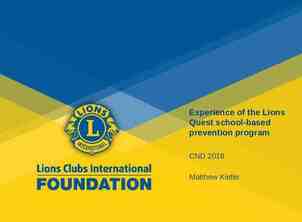EMT IM Epinephrine Administration Connecticut State Education and
56 Slides8.30 MB
EMT IM Epinephrine Administration Connecticut State Education and Training Committee 2019 Connecticut Department of Public Health St Keeping Connecticut Healthy
Goals and Objectives (1 of 2) EMT will review signs/symptoms of allergic/anaphylactic reactions. EMT will review the actions, indications and contraindications of epinephrine. EMT will review OEMS epi administration protocol with “IM” administration update. EMT will learn & demonstrate how to properly select “IM” injection site for epi. EMT will learn & demonstrate how to properly select and prepare injection syringe.
Goals and Objectives EMT will learn & demonstrate proper drawing up and dosing of epi for selected patient age. EMT will learn & demonstrate correct “IM” injection with provided equipment EMT will review the signs/symptoms that require re-dosing of epi. EMT will successfully complete state provided quiz.
The Check and Inject Program Connecticut Department of PublicState HealthEducation and Training Connecticut Keeping Connecticut Healthy Committee 2019
Check and Inject – Why? Decreased availability of auto injectors Rising cost of auto injectors Demonstrated success: King County, Washington New York State Massachusetts New Hampshire
Terms/Abbreviations Circumoral – surrounding the mouth IM – Intramuscular mg - Milligrams mL - Milliliter SQ - Subcutaneous To convert Lbs to Kgs Lbs / 2.2 Kgs
Identifying Allergic Reactions Connecticut Department of Public Health and Training Committee Connecticut State Education Keeping Connecticut Healthy 2019
Types of Reactions Minor Allergic Reaction Major Allergic Reaction – Anaphylaxis
THE “MYTH” “You can’t have a reaction to something you haven’t been exposed to before” NOT TRUE!!! If it looks like a duck, walks like a duck and quacks like a duck It’s a duck!!! Treat it!!!
Minor Allergic Reaction Isolated body system reaction Itching Hives - isolated Runny nose Sneezing Watering eyes
Major Allergic Reaction (Anaphylaxis) Two or more body systems affected Airway/breathing compromise Rapid onset of symptoms Systems often affected: Respiratory Cardiovascular Integumentary Gastrointestinal
Signs & Symptoms Major Allergic Reactions Connecticut State Education Connecticut Department of Public Health and Training Committee Keeping Connecticut Healthy 2019
Respiratory System Dyspnea Hoarse voice/Stridor Wheezing, Rales or Rhonchi Swelling of lips and tongue Any respiratory system compromise validates treatment for anaphylaxis!!
Cardiovascular Tachycardia Hypotension Circumoral cyanosis NOTE: Hypotension isn’t a pre-requisite for treatment. Some anaphylaxis patients experience hypertension, or normal blood pressures.
Integumentary System Itching Hives Flushing of skin (decreased vascular tone) Angioedema Especially around face, mouth, eyes, tongue
Gastrointestinal system Nausea Vomiting Diarrhea
Properties of Epinephrine Connecticut State Education and Training Committee Connecticut Department of Public Health Keeping Connecticut Healthy 2019
Epinephrine Actions Constricts skin blood vessels Improved central circulation, decreased GI upset Increases heart rate and force Increases dropping blood pressure Dilates bronchioles Decreases dyspnea, increases oxygenation Inhibits histamine release (cause of hives, itching)
Epinephrine Indications Signs and symptoms of anaphylaxis Progression of allergic reaction Contraindications In anaphylaxis – NONE Side effects Palpitations Chest pain Anxiety/Jitteriness (tremor) Headache
Epinephrine Risk of overdose Tachycardia Myocardial ischemia (heart muscle damage) Not a reason to withhold medication FACT: Do Not change the protocol dose of 0.3mg for the adult patient, no matter their age.
Connecticut EMS Protocol Connecticut State Education and Training Committee Connecticut Department of Public Health Keeping Connecticut Healthy 2019
EMT Level – Adult Patient Oxygen May still use auto-injector or May select “Check and Inject” method Over 25 kg (55lbs) – 0.3 mg of 1 mg in 1 ml epinephrine (1:1000), administered IM (intramuscular) in the lateral thigh. If in 5 minutes symptoms not resolving or worsening contact medical control for potential second dose. No other meds at this level (antihistamines, bronchodilators, steroids, etc.)
EMT Level – Pediatric Patient Oxygen May still use auto-injector May select “Check and Inject” method Under 25 kg(under 55lbs) – 0.15 mg of 1 mg in 1 ml epinephrine (1:1000) administered IM (intramuscular) in the lateral thigh. If in 5 minutes symptoms don’t resolve or worsen contact medical control for potential second dose of epi. No other meds at this level (antihistamines, bronchodilators, steroids, etc.)
Assessment Scene Safety BSI Primary Assessment Oxygen Administration Secondary Assessment Respiratory Cardiovascular Integumentary Gastrointestinal
Selection of Injection Site Lateral mid-thigh Vastus lateralis muscle Muscle tissue remains well perfused during shock Current evidence supports this site over others for IM or SQ Reduces risk of injection in vein or artery which can cause: Tachycardia Cardiac compromise
Adult Lateral Thigh
Pediatric Lateral Thigh
6 Rights of Medication Administration Right Patient Right Medication Right Route Right Dose Right Time Right Documentation
Right Patient Does this patient meet the protocol for anaphylaxis? Signs and symptoms of severe allergic reaction Suspected history of allergy Suspected exposure to allergen Previous use of epinephrine
Right Medication Confirm label 1 mg in 1 ml (1:1000 concentration) Not cardiac epinephrine
Right Route IM Intramuscular – Lateral Mid-Thigh Avoid blood vessels Prevent injection directly into circulation Avoid superficial layers of skin Prevent delayed absorption Avoid distal extremities Decreased perfusion in shock state
Right Dose Adult 55lbs/25kgs 0.3 mLs Pediatric 55lbs/25kgsP 0.15 mLs
Right Time Administer 1st dose promptly If symptoms don’t improve or resolve w/ in 5 minutes call medical control.
Drawing Up Medication Education Connecticut Connecticut DepartmentState of Public Healthand Training Committee Keeping Connecticut Healthy 2019
Medication Containers Vial Ampule Remove lid Break top Do inject air Do NOT inject air Can be done w/ Tilt sideways or upside down Consider using a filter needle Replace filter needle w/ a injection needle (if filter needle used) vial standing upright or tilted upside down.
Aseptic Technique Handling, preparing and storing medications and injection equipment to prevent microbial contamination Use a new syringe and needle every time Store equipment in sterile packaging until use Swab containers and skin with antiseptic Avoid touching contact points Needle Vial lid Skin Syringe connector
Using an ampule 1. 2. 3. 4. 5. 6. 7. Confirm medication Tap contents to bottom Wipe with antiseptic swab Break neck (use gauze or swab wrapper) Insert filter/injection needle Withdraw medication Replace filter needle w/ a new needle for injection (if filter needle used) 8. Discard ampule safely in sharps container
Needle Size Appropriate gauge for intramuscular injection is 22-25 gauge Appropriate length for intramuscular injection: Infant (0-12mos) - 5/8 (16mm) 1y/o-2y/o - 5/8-1” (16-25mm) 3y/o-10y/o - 1” (25mm) 11-Adult - 1-1.5” (25-38mm)
Drawing from an Ampule *Disregard comment concerning larger epi in ACLS bags*
Using a Vial (1 of 2) 1. 2. 3. 4. Confirm medication Remove plastic lid Wipe stopper with antiseptic swab Fill syringe with air (equal to volume of medication wanted.) 5. Insert needle, inject air. (There is no need to change needle when using a vial for injection) 6. Withdraw medication, remove needle. 7. Discard vial safely in sharps container
Drawing from a Vial *Please always use a syringe with a safety capping feature!*
Using a Vial (2 of 2)
Confirm medication Speak out loud Ask partner to confirm If no partner – still state medication out loud “I have 0.3 mL’s of epinephrine. Does that look correct?”
Prepare Syringe for Injection Hold syringe upright Allow bubbles to rise Push out remaining air Use caution – do not lose medication when ejecting air
Prepare the injection site Select location (lateral mid thigh) Swab with alcohol or chlorhexidine wipe Avoid touching site after cleaning
Insert at 90 degrees (straight in) (Make sure you are NOT using filter needle) Pull back plunger ¼ inch (i.e. aspirate) – look for blood If visible blood, stop injection If no visible blood, continue injection Press plunger all the way in Remove needle (using safety device to cap it) Press on or massage injection site Dispose of needle properly in sharps container
IM Injection (Video)
Additional Doses Reassess patient Should see improvement within 2 minutes of epi dose Is there improvement in respiratory symptoms? Has angio-edema reduced or resolved? Are vital signs improving? Vomiting/Diarrhea ceased? If the answer is NO! Re-dose (every 5 minutes) with Medical control permission.
Documentation Document accurately in ePCR List initial findings Vital signs Work of breathing General appearance Lung sounds Airway patency Document dose and route Document any errors Document reassessment
Documentation Tips Use correct medication box or tab on ePCR Data driven reports cannot read from narrative section Include in narrative also Medication documented as listed below: 0.3/0.15mg epinephrine administered “IM” (location)
Medication Errors Incorrect dose given (too much, too little) If too little, consider additional dosing Incorrect route of administration Too shallow – subcutaneous Venous delivery – prevented by aspirating prior to injection Unnecessary administration Routine minor allergy Different diagnosis Mechanical failure Needle breaks Ampule or vial shatters
Thank you to the State of NH for developing this chart.
PEARLS Ensure injection syringes have self-sheathing needles. (Per Needle stick Safety and Prevention Act). Ensure provider is using 2x2 or alcohol prep to “crack” open ampule. (Helps prevent cuts) Ensure provider changes out filter needle once medication is withdrawn from ampule – and changed out for proper injection syringe Ensure “pre-made” kits from manufactures have proper self-sheathing needles.
Next Steps Take Quiz Schedule and successfully complete skills station
References [Angioedema]. Retrieved from https://www.google.com/search? rlz 1C2KDEC enUS827&tbm isch&q angioedema&chips q:angioedema,g 1:tongue:apQ7QL -1jc %3D&usg AI4 kQ61iMMQ L3Er7OzSQ9M U5nKdoPQ&sa X&ved 0ahUKEwiM1 S94KXfAhWIllQKHfgpBbMQ4lYILi gA&biw 934&bih 658&dpr 1.25 CDC. (n.d.). Vacccine administration. Retrieved from CDC website: https://www.cdc.gov/vaccines/hcp/acip-recs/general-recs/administration.html Have Dummy Will Travel, Inc. (2018). Epi 1:1000 draw [Video file]. Retrieved from https://www.youtube.com/results?search query drawing meds from a vial [Hives]. Retrieved from http://www.google.com/search? q hives&rlz 1C2KDEC enUS827&source lnms&tbm isch&sa X&ved 0ahUKEwjYgri36XfAhVDyFQKHbQIDr4Q AUIDigB&biw 1536&bih 674&dpr 1.25 Kroger, A., Atikinson, W., Marcuse, E., & Pickering, L. (2006). General recommendations on immunization. Retrieved from CDC website: https://www.cdc.gov/MMWR/PREVIEW/MMWRHTML/rr5515a1.htm#tab7
References Monroe Livingston EMS Council. (2017). Check & inject NY training materials. Retrieved from https://www.mlrems.org/check-inject-ny/check-inject-ny-training-materials Schramm, J. (2016). Epi ampule training [Video file]. Retrieved from https:https://www.youtube.com/results?search query drawing meds from an ampule// www.mlrems.org/chec k-inject-ny/check-inject-ny-training-materials Simula, T. (2017, October 15). Vastus Lateralis injection [Video file]. Retrieved from https://www.youtube.com/watch?v e0BRa8exQjQ





























































